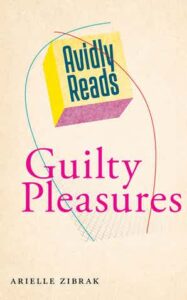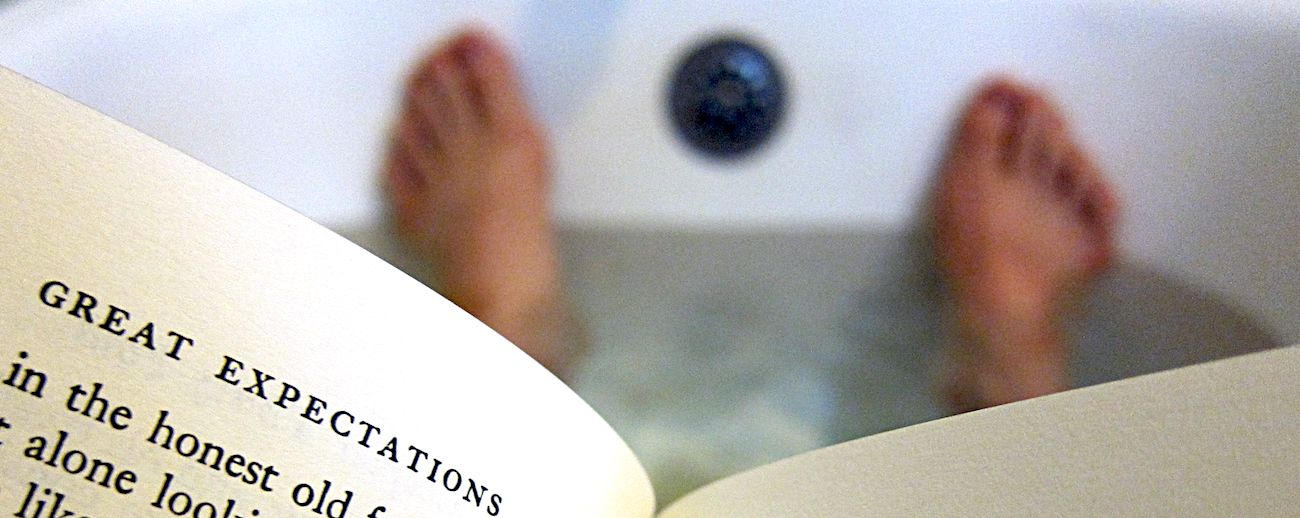When someone refers to a guilty pleasure, they’re usually making a kind of narcissistic claim about a textual object that is attractive to yet beneath them: “I mostly read the New Yorker, but US Weekly is my guilty pleasure.” I think a more accurate term for the “guilt” implied in this kind of statement may be “shame.” When someone says something like this, they seem to mean they’re ashamed because they know how bad it is but enjoy it nonetheless in spite of that shame.
The author and speaker Brené Brown, a self-defined “shame researcher,” writes that there is “a profound difference” between shame and guilt, primarily because she sees guilt as productive—a place where we can identify how to improve our lives by aligning our actions with our values—whereas shame is an unproductive welter of negative feelings.
My sense of shame is different from Brown’s. I’m less interested in what we do with those feelings than I am in why we have them. I’m also a little skeptical of any emotional logic that holds productivity as a guiding virtue. A fundamental proposition of this book is that not everything in our lives has to be “productive” in the forward-looking sense or aligned with our values or even the kind of “positive” defined by motivational posters with images of icebergs or sunsets or small animals in compromised circumstances.
I think the pervasive demand that people—especially female people—be productive and positive produces the majority of the guilt and shame we experience. I can’t condone advice to smile more or work harder. The only general advice I can get behind is along the lines of “travel abroad” or “take a bath”—means to no clear end or product beyond themselves. Travel because other places have better food and different languages. Take a bath because the point of a bath is the bath. I find that enormously edifying. With Kant, I urge us to act as if our bath pleasure is not a means to an end but rather an end in itself.
Guilty pleasure texts are like baths for the mind. They’re usually cast as mindless or unproductive. My first objection here is, predictably, that therein lies a particularly bad account of productivity. Pleasure is productive; it produces itself. My second is that if you’re a thinking person, you can think “productively” through any object—an essay by Susan Sontag or a Ke$ha lyric—and if NPR ever asked for my “This I Believe” statement, I would say, with Virginia Woolf, that I think people should consume whatever media they like without any sense of shame or pride. While I’m at it, I’d also like to ask why the guys I internet-dated in the aughts lied about having read all of the Faulkner or Joyce novels they claimed to have read on their profiles. It’s a curious, and frankly puritanical, notion that what you consume defines you or—worse—ranks you, that a person is only as good or as terrible as their most-listened-to songs and the spines on their shelves.
My mentioning here of internet-dating is not merely casual, because once again it demonstrates how reading attaches to our sense of the love we deserve. Those dudes advertised Faulkner, I guess, because they were trying to position themselves as worthy of a Faulkner-quality love—sophisticated, serious, complex? This is a disturbing thought in several respects, and yet it also raises the fascinating question of why and how Faulkner-love raises itself above, say, a Babysitters Club kind of love. To answer this question, some literary criticism may be helpful.
I can accept the category of “guilty pleasures” as a name for things that give us a pleasurable release from guilt and shame or space to dwell within it.I was born at the end of 1981, the same year that the literary scholar Fredric Jameson published his landmark work The Political Unconscious, a book that has shaped my thinking in so many ways that I’m continually disappointed that I didn’t write it myself before I was born. In it, he argues that history itself is a narrative that unfolds alongside the other narratives—for instance, fictions—that shape our culture. According to Jameson, we can’t separate the two by attempting to interpret fictions outside of their political or historical context, nor can we understand our own history without understanding our fictions.
Jameson’s interpretive project develops out of his cultural understanding: we tend to think of the unconscious as an individually experienced phenomenon. But cultures, he claims, have unconsciousnesses, too. Documents of popular culture, in particular, tell us a lot about what the people who created and consumed them were thinking, feeling, and desiring. If ship manifests and medical records and military logs and patent files are the kinds of documents that reveal the history of our migrations, conflicts, and technologies, popular fictions are the kinds of documents that tell us about the history of our hearts and minds.
A sadly unsurprising thing about The Political Unconscious is that Jameson makes his argument through interpreting fiction written almost exclusively by white men. (Jameson doesn’t actually mention Faulkner but does mention Joyce.) (Obviously, prebirth me would have done otherwise.) The very white maleness of his work is one reason why scholars, myself included, have long perceived it as Extremely Important. In a review of Emily Nussbaum’s I Like to Watch, the critic Sarah Mesle identifies the source of this phenomenon as the “circular logic by which a piece of art becomes serious because a serious critic attends to it, and a critic becomes serious by tending to serious art.” The prevalence of this brand of logic also explains why the history of men, like the fiction and culture of men, is almost always taken to be more serious than the history of women.
My point in raising Jameson—in veering precipitously toward Serious Pleasure rather than the guilty kind you came here to read about—is that I want to take Jameson both as a useful thinker and as an example of the unconscious he’s describing: The Political Unconscious is a document of an intellectual unconscious whereby male things are the ones that tell us what “our” collective unconscious is like. This book you are reading, on the other hand, is not very interested in that. Guilty pleasures, I am going to propose, reveal a collective unconscious of a consciousness that Jameson ignored: the femme one.
When I was taught history in high school, it was the serious male kind. My class was held in a room encircled by a wallpaper border depicting the presidents of the United States of America (unfortunately, not the nineties alt-rock band that recorded “Peaches” but the actual leaders of the nation in which I was born). So, like many of you I’m sure, I was forced to sit in a space that was literally covered in the faces of white men while a white man told me to read about and memorize the names of white men and the things they did. I understand why white men like this history; it belongs to them. But I have heard enough of it and no longer find it very interesting. To me, learning this history over and over again is like having a conversation with someone who only talks about himself. No matter how many things he’s done or how witty or insightful his ideas may be, at a certain point you’re going to need to switch topics or say you have to use the restroom and politely walk away forever.
When I teach American literature, I tend to focus on work by women writers, queer writers, and writers of color for no better reason than that I find these works more interesting to read. Most of my students do, too, but sometimes I get a complaint. “Why don’t we learn more about war?” some students have asked. “We do learn about war,” I reply, citing Richard Wright’s 1940 Native Son, which is about systemic racism, midcentury communist sympathy and its vilification, and widespread physical violence. Those are wars. Students tell me these are not the wars they mean. I tell them how Edith Wharton’s 1920 The Age of Innocence is about the aftermath of World War I—a good, solid white man’s war. They shake their heads. But then, sometimes, they come to see how it is true. It was only when I got to college myself that I really understood that history could be something other than leaders and battles and captains of industry. I took a course called Women in Europe that was a history of the lives of women—a revelation! I immediately became a history major.
Of course, the women who’ve written novels throughout history do the exact same thing that Jameson’s male novelists do. They narrate the psychic and emotional history of another time—their psychic and emotional history. Louisa May Alcott’s 1869 Little Women, for example, is also a novel about a war—the American Civil War—but unlike Stephen Crane’s snooze of a novel The Red Badge of Courage (1895), it’s not about the men on the battlefield. It’s about the women at home, who are doing real, serious, important things as well. These women may be more left out of History, but they were not left out of life; and what happened off the battlefield is just as important as what happened on it.
Despite this and even how beloved and respected Alcott’s novel is, I don’t often see people carrying around a prestige copy of Little Women the way they might Moby Dick or Ulysses or Gravity’s Rainbow or Infinite Jest. But Little Women and other novels written by the women of the past can also make you smarter if you actually read them. And they have a lot to tell us about what people were like then and how we became who we are now. This is why many of us find reading these books so deeply pleasurable, even as we may feel ashamed of that pleasure, because so much of our world has told us that this kind of becoming isn’t important, that it (and we) don’t matter.
In addition to revealing some truths about our collective unconscious, novels help us to work through whatever it is we’re dealing with as a society and as individuals. If anything about this kind of media consumption is self-definitional, it’s the shame associated with it—not because “guilty pleasures” reveal some fundamental truths about the consumer’s lowbrow aesthetic tendencies but because a lot of the genres of movies and television that get referred to as “guilty pleasures” are also another kind of guilty pleasure, what I like to think of as the Hester Prynne kind, where guilt is what’s being pleasurably stimulated alongside libidos and baser desires for nice hair and fancy things.
In this sense, I can accept the category of “guilty pleasures” as a name for things that give us this pleasurable release from guilt and shame or space to dwell within it. And, in general, I think many Americans of many different gender circumstances prefer their pleasures guilty. This is a country that advertises potato chips with the slogan “bet you can’t have just one,” where Titanic and Jurassic Park (two of the highest grossing films of all time) both have the same general plot: some novel delights immediately followed by sudden mass death. One easy answer is to blame the Puritans—Nathaniel Hawthorne did. His 1850 novel The Scarlet Letter is basically the textbook on guilty pleasure.
The Scarlet Letter shows us that the pleasures of the sex you can’t have or see are inextricable from the guilt that is yours for the taking.In my memory, my classmates and I were assigned this book more than once in high school and maybe another couple of times before that in junior high. (I’d already read my mother’s college copy early on, selected for priority status because it had a monochromatic print of a lady in a bonnet on it.) Because I grew up in Massachusetts, when we weren’t reading The Scarlet Letter, we were on seemingly constant field trips to Salem to learn about the witch trials for the fourth or fifth time; then we’d swing by the House of the Seven Gables and the Custom House where Hawthorne worked and learn about Hawthorne and The Scarlet Letter all over again for good measure. (We’d go to Thoreau’s cabin site at Walden, too, but never the Alcott house or the Dickinson house, which were certainly within easy bus distance.)
I claimed in my tenth-grade paper on this one book that every single American teenager seems to be made to read that Hester Prynne, the infamous adulteress forced into wearing the letter A, likes her punishment. I based this claim primarily on this passage: “On the breast of her gown, in fine red cloth, surrounded with an elaborate embroidery and fantastic flourishes of gold-thread, appeared the letter A. It was so artistically done, and with so much fertility and gorgeous luxuriance of fancy, that it had all the effect of a last and fitting decoration to the apparel which she wore.”
This was my favorite part of the book. First, it was undeniably punk that she went in this over-the-top direction with a sartorial mandate. Second, the language here about a patch sewn onto a puritan dress for punishment is somehow just oozing with sensual pleasure: fantastic flourishes, gorgeous luxuriance of fancy, fertility. I submitted a paper explaining this in slightly different words to my teacher, who did not like the argument. She sat me down, sitcom-style, to explain that this was a text about ostracism and group think and for me to suggest that Hester Prynne took pleasure—let alone sensual pleasure—in her guilt and punishment was very disturbing and wrong-headed.
I can’t bear a grudge against this teacher because I respect anyone who teaches high school English (I didn’t then, so this blind respect is my best consolation) and also because our field-trip pattern had The Scarlet Letter so thoroughly mixed up with the real historical witch trials in everyone’s minds, but I did feel a surge of triumph when I later encountered the fact that my paper wasn’t very far off from one of the most prevalent critical readings of the novel since 1960, when the literary critic Leslie Fiedler argued that The Scarlet Letter is definitely about the fraught nature of sexual desire in America. Fiedler claimed that American literature is incapable of depicting mature sexual relationships—that it falls back on the eroticization of children, unconsummated sexual love between men, and “old maids.” (He was smart but totally a man of his time.)
For Fiedler, The Scarlet Letter was the sexiest book in the canon of great American literature, though, tellingly, all of the sex happens before the book even begins—like if Crime and Punishment were just the brutally boring punishment part. While Fiedler emphasized sexual desire as the fulcrum of the novel, he also acknowledged—like most of the novel’s readers before him—that its central theme is undeniably guilt, asking why, to Hawthorne (not just the puritans), “is gorgeousness a trap and love a crime, why beauty forbidden and joy banned?” To which I’d answer: because for a lot of people these things, freely given, would be less pleasurable. It’s not as if the pleasure is one thing and the guilt is another. Perhaps guilt kills Dimmesdale, but Hester thrives on it. And so do readers along with her. The Scarlet Letter shows us that the pleasures of the sex you can’t have or see are inextricable from the guilt that is yours for the taking.
If you watch the 1995 film version of The Scarlet Letter, starring Demi Moore, you’ll see that the filmmakers get the sexiness part right but miss both most of the guilt and how important it is that no sex happens in the novel. In the novel, the readers only get the pleasure of the implied sex through the author’s refusal to give it to us. If we saw Hester and Dimmesdale getting it on, it would be a bad book in 1850 to say the least. When we see it in 1995, it’s still a bad movie—especially since the sex scenes are bizarrely interspersed with some impressionistic montage sequences. It’s not a very good adaptation of the main themes of Hawthorne’s novel if it’s full of Demi Moore taking long baths and having her farthingale slowly unlaced by Gary Oldman. But neither can you take all of the sex out of The Scarlet Letter, implications included.
The updated-for-our-times 2010 version starring Emma Stone, Easy A, gets the guilt part right but is pretty rigorously unsexy. The center of the plot is actually the revised fact that the Hester character is a virgin. The story of her tryst is fabricated, so we don’t even get to imagine that it has happened in the pre-history of the movie. Her guilt (about having lied about having had sex when she hadn’t—can you imagine what the original Hester would think?) is just guilt-guilt and regret-regret, no fantastic flourishes or gorgeous luxuriance of fancy about it. While Emma Stone skulks around a California high school in strangely bedizened corsets (where do they come from? why are there so many?) she seems to take no real pleasure in doing so. I think the very point of The Scarlet Letter is that at least half of the pleasure (sexual and otherwise) to be found in the novel is the guilt.
__________________________________

Excerpted from Avidly Reads Guilty Pleasures by Arielle Zibrak with permission from New York University Press.


